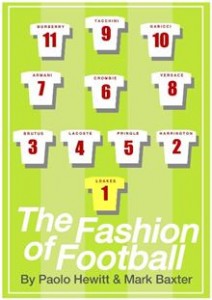 The illustrated hardback edition of this book was published by Mainstream Publishing in November 2004, with an eBook distributed by Wholepoint Publications in August 2011. It is the latter version of this work by Paolo Hewitt and Mark Baxter that was read for the purposes of this review. This detailing of the date and format may not seem the normal way to start a review, but in one of those strange twists of fate it became relevant when reading the eBook.
The illustrated hardback edition of this book was published by Mainstream Publishing in November 2004, with an eBook distributed by Wholepoint Publications in August 2011. It is the latter version of this work by Paolo Hewitt and Mark Baxter that was read for the purposes of this review. This detailing of the date and format may not seem the normal way to start a review, but in one of those strange twists of fate it became relevant when reading the eBook.
Towards the end of the book there is a chapter entitled United Colours of Beckham which for the most part extols the virtues of the lad from East London and his place as both footballer and fashion role model. However, when the hardback edition was released at the back end of 2004, Hewitt and Baxter reflected;
“…2004 arrived and with it a massive sea change. Beckham’s form dipped badly…during this torrid time on the field came another storm, this time from outside. Beckham was publicly accused of infidelity, a massive blow to his image as devoted family man…Beckham travelled to Portugal to captain England in the Euro 2004 tournament…often he seemed tired, somewhat lost even as the battle raged around him…by the tournaments end…Beckham faced the press…knowing it was Wayne Rooney the advertisers now desired…”
Hindsight is a wonderful thing, but in the eight years since, Beckham has proved himself to be an iconic figure. His England career extended to 115 caps and he became integral to a successful Real Madrid team, before taking on new challenges in the USA with Los Angeles Galaxy and loan spells with AC Milan. From fashion through to his role as an Ambassador for the 2012 London Olympics, David Robert Joseph Beckham has been there and done it. As I finished the last pages of this eBook, Beckham announced that he was moving on again, looking for one last football challenge in his career. Even once his boots are finally hung up, you know that Beckham will still be in the limelight, an influential figure. Wayne Rooney? Well 2004 may prove to be the highlight of his international career. Compare the brilliance and exuberance of the teenager who burst onto the scene in Portugal to the sneering man who slatted England fans who dared to complain about the abysmal World Cup campaign in South Africa in 2010. I may be wrong, but…
However, returning to the eBook. In terms of its writers, Paolo Hewitt (a Spurs fan), has a background in music, having worked as a journalist on NME and been involved in numerous books of the musical genre. He also collaborated with Oasis bassist Paul McGuigan on a book about Reading and Cardiff City player, Robin Friday, titled The Greatest Footballer You Never Saw. The Fashion of Football was co-writer Mark Baxter’s (a Millwall season-ticket holder), first venture into the publishing world. Both men are fanatics of the trinity that is, football, fashion and music. The love and understanding of these topics translates into this book. Indeed the relationship between the two writers creates a very readable and comfortable conversational tone. Hewitt and Baxter whilst knowledgeable about the subject matter, also show us that they are still fans at heart, and are ‘star-struck’ in carrying out some of the interviews transcribed in the eBook. Amongst those interviewed from the football world were ex-players Alan Hudson, Alan Birchenall, Frank McLintock, Mike Summerbee, Steve Perryman and the “Peckham Beckham” Darren Ward (who was playing for Millwall back in 2004). From the music industry there are contributions from Steve Diggle, Paul McGuigan and Kevin Rowland, whilst from fashion, included are Mark Powell, Tim and Olaf Burro and William Hunt.
The content is really divided into two elements. The first takes the reader on a journey through the development and influence of players on fashion (and vice-versa). 1962 is used as the starting point, as this was the year that the maximum wage for footballers was abolished and therefore suddenly provided them with disposable income to spend, on such items such as clothes. Figures such as George Best and the London set of the 1960’s and 70’s including Bobby Moore and Martin Peters (both West Ham United), Peter Osgood, David Webb and Eddie McCreadie (all Chelsea), are all detailed as the hand-made suit swept through the football fraternity. The King’s Road, Carnaby Street and Savile Row are all here as the journey continues through the various decades to the 2004, from the infamous FA Cup Final Liverpool FC ‘white suits’ to the perms and mullets of Keegan and Waddle. A journey which has seen footballers become fashion followers and in some cases icons. In the second section, the focus is more on the terrace culture and what was ‘in’ and ‘out’ for the football fashionitas, as the rise of ‘labels’ came to the fore. Running through both elements are brief descriptions from the clothes and hair perspectives of particular times and fashions, which were great little insights. These started with, The Mod’s Formal Dressing Room 1963 and went through the following, The Mod Casual’s Dressing Room 1965, The Skinhead’s Dressing Room 1970, The Suedehead’s Dressing Room 1972, The Soulboy’s Dressing Room 1973, The Casual’s Dressing Room 1982, The Formal Label Slave’s Dressing Room 2004, finishing with The Casual Label Slave’s Dressing Room 2004.
Ultimately, it was a book I did enjoy and would recommend for the fact that it does provide a different angle on football through the mediums of fashion and music. The writers’ enthusiasm is infectious, and the level of research is impressive and both translated to me as a reader. My one gripe with the eBook is that despite the great subject matter, it suffers, because unlike it hardback original, there are no pictures or illustrations to support the images that the words create. Despite that though, worth a read.
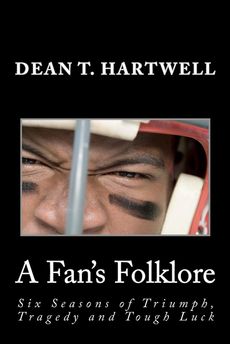 Sport is often held up as a metaphor for life; no matter what the sport, the country that it is played in or whether you experience it as a participant or spectator. Dean T. Hartwell takes his early years watching his beloved Oakland Raiders in the National Football League (NFL) and Los Angeles Dodgers of the Major League Baseball (MLB) to illustrate how they taught him lessons in ways he “…could not have otherwise understood…”
Sport is often held up as a metaphor for life; no matter what the sport, the country that it is played in or whether you experience it as a participant or spectator. Dean T. Hartwell takes his early years watching his beloved Oakland Raiders in the National Football League (NFL) and Los Angeles Dodgers of the Major League Baseball (MLB) to illustrate how they taught him lessons in ways he “…could not have otherwise understood…” Some say football is a metaphor for life, others state that life is a journey; so what does it say if you set yourself the task over a ten month period to complete a 10,000 mile journey on a bicycle watching every single game played by your team (home and away) in the Conference National and FA Cup in the 2009/10 season?
Some say football is a metaphor for life, others state that life is a journey; so what does it say if you set yourself the task over a ten month period to complete a 10,000 mile journey on a bicycle watching every single game played by your team (home and away) in the Conference National and FA Cup in the 2009/10 season? My allegiance is to Fulham, it’s where I was born and they are the team I have supported since my first ‘live’ game in 1972. However, there are teams you get a soft spot for, a club whose results you look out for. That club for me is Wimbledon FC. The first time I went to Plough Lane was in January 1976 for an FA Trophy 1st Round Replay game against Sutton United. I’d never been to watch non-league football, but something that night hooked me in. Over the following years I regularly attended games at Wimbledon when Fulham were away and was fortunate enough to be there for some memorable games, including the victory against Minehead in May 1977 which went a long way to sealing the Southern League Premier Division, the first game in Division Four against Halifax Town in August 1977 and an FA Cup victory over Brian Clough’s Nottingham Forest in January 1985. By the time I left London in August 1991 to live in Leeds, Wimbledon were an established First Division team, but had been forced to leave Plough Lane and were about to start life at Selhurst Park. Not being in the capital, I had to follow the disturbing rumours of The Dons move to Dublin and Milton Keynes from afar, but ultimately didn’t believe that The FA would sanction this most invidious of proposals. However, history tells us that the unfathomable decision came to pass and which subsequently led to the beginning of another chapter in the history of The Dons when AFC Wimbledon were born in 2002.
My allegiance is to Fulham, it’s where I was born and they are the team I have supported since my first ‘live’ game in 1972. However, there are teams you get a soft spot for, a club whose results you look out for. That club for me is Wimbledon FC. The first time I went to Plough Lane was in January 1976 for an FA Trophy 1st Round Replay game against Sutton United. I’d never been to watch non-league football, but something that night hooked me in. Over the following years I regularly attended games at Wimbledon when Fulham were away and was fortunate enough to be there for some memorable games, including the victory against Minehead in May 1977 which went a long way to sealing the Southern League Premier Division, the first game in Division Four against Halifax Town in August 1977 and an FA Cup victory over Brian Clough’s Nottingham Forest in January 1985. By the time I left London in August 1991 to live in Leeds, Wimbledon were an established First Division team, but had been forced to leave Plough Lane and were about to start life at Selhurst Park. Not being in the capital, I had to follow the disturbing rumours of The Dons move to Dublin and Milton Keynes from afar, but ultimately didn’t believe that The FA would sanction this most invidious of proposals. However, history tells us that the unfathomable decision came to pass and which subsequently led to the beginning of another chapter in the history of The Dons when AFC Wimbledon were born in 2002.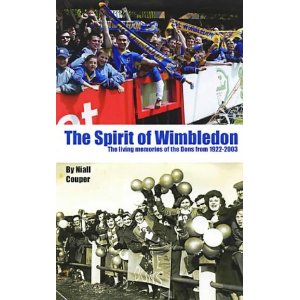 This Is Our Time – The AFC Wimbledon Story by Niall Couper recounts the incredible tale of the rise from the Combined Counties League (CCL) back to the Football League. Couper started following The Dons in 1982 and watched the club at Plough Lane and Selhurst Park. With the release of Charles Koppel’s plan to take Wimbledon to Milton Keynes in 2001, fans looked to boycott official merchandise. An alternative match-day programme, Yellow and Blue, came into existence edited by Couper, which in their inaugural season in the CCL became the ‘official’ club programme for AFC Wimbledon. In addition to this book, Couper was also the author of, The Spirit of Wimbledon – The living memories of the Dons 1922 – 2003. Both books are available from the publisher
This Is Our Time – The AFC Wimbledon Story by Niall Couper recounts the incredible tale of the rise from the Combined Counties League (CCL) back to the Football League. Couper started following The Dons in 1982 and watched the club at Plough Lane and Selhurst Park. With the release of Charles Koppel’s plan to take Wimbledon to Milton Keynes in 2001, fans looked to boycott official merchandise. An alternative match-day programme, Yellow and Blue, came into existence edited by Couper, which in their inaugural season in the CCL became the ‘official’ club programme for AFC Wimbledon. In addition to this book, Couper was also the author of, The Spirit of Wimbledon – The living memories of the Dons 1922 – 2003. Both books are available from the publisher  If you wander into a bookshop and look at the section on Leeds United AFC, the shelves will invariably be loaded with titles which hark back to the Revie era and the exploits of his teams of the 1960s and 70s. Whilst those trophy winning days at Elland Road put the West Yorkshire club onto the footballing international stage, they were not the last Leeds team to bring the League title back to LS11. In 1991/92 under Howard Wilkinson, Leeds took the First Division title by four points from Manchester United, yet the story seems to have been fairly much passed over. In The Last Champions (Leeds United and the year that football changed for ever), Dave Simpson has brought that extraordinary season to life.
If you wander into a bookshop and look at the section on Leeds United AFC, the shelves will invariably be loaded with titles which hark back to the Revie era and the exploits of his teams of the 1960s and 70s. Whilst those trophy winning days at Elland Road put the West Yorkshire club onto the footballing international stage, they were not the last Leeds team to bring the League title back to LS11. In 1991/92 under Howard Wilkinson, Leeds took the First Division title by four points from Manchester United, yet the story seems to have been fairly much passed over. In The Last Champions (Leeds United and the year that football changed for ever), Dave Simpson has brought that extraordinary season to life.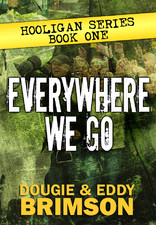 Dougie and Eddy Brimson’s first book of their Hooligan series sets out to explain the phenomenon of football hooliganism; “who causes violence, why, how and when they do it; about what can be done and by whom to try and stop it” and it is also a robust defence of football fans against lazy journalism and stereotyping.
Dougie and Eddy Brimson’s first book of their Hooligan series sets out to explain the phenomenon of football hooliganism; “who causes violence, why, how and when they do it; about what can be done and by whom to try and stop it” and it is also a robust defence of football fans against lazy journalism and stereotyping. Chris Winter is a Crystal Palace fan who has watched his beloved team since 1969 and which have given rise to two books. The first
Chris Winter is a Crystal Palace fan who has watched his beloved team since 1969 and which have given rise to two books. The first 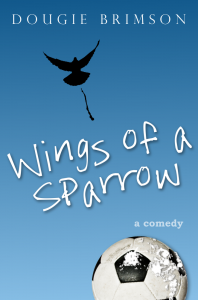 As football fans we love our club with a passion. We also have by tradition, rivals; the team we love to hate, the one that we love to see struggle, the one that by beating brings boundless joy and local bragging rights. But what would you do if you found yourself in charge of the enemy, as Chairman of your bitterest rivals?
As football fans we love our club with a passion. We also have by tradition, rivals; the team we love to hate, the one that we love to see struggle, the one that by beating brings boundless joy and local bragging rights. But what would you do if you found yourself in charge of the enemy, as Chairman of your bitterest rivals? The illustrated hardback edition of this book was published by Mainstream Publishing in November 2004, with an eBook distributed by Wholepoint Publications in August 2011. It is the latter version of this work by Paolo Hewitt and Mark Baxter that was read for the purposes of this review. This detailing of the date and format may not seem the normal way to start a review, but in one of those strange twists of fate it became relevant when reading the eBook.
The illustrated hardback edition of this book was published by Mainstream Publishing in November 2004, with an eBook distributed by Wholepoint Publications in August 2011. It is the latter version of this work by Paolo Hewitt and Mark Baxter that was read for the purposes of this review. This detailing of the date and format may not seem the normal way to start a review, but in one of those strange twists of fate it became relevant when reading the eBook. This book is an absorbing mix of fact and fiction that details the factual life of Leeds United and the fictional life of a young Leeds fan throughout the Don Revie era. The fictional life of Jimmy O’Rourke is set amid real events both at the club and in the city of Leeds which adds context to the footballing narrative of Don Revie’s transformational time as manager of the club from 1961 to his departure to take up the England manager’s post in 1974.
This book is an absorbing mix of fact and fiction that details the factual life of Leeds United and the fictional life of a young Leeds fan throughout the Don Revie era. The fictional life of Jimmy O’Rourke is set amid real events both at the club and in the city of Leeds which adds context to the footballing narrative of Don Revie’s transformational time as manager of the club from 1961 to his departure to take up the England manager’s post in 1974. Let’s start by getting a few things out of the way. Firstly, this book is an example of where you have to be brutally honest and say that the proof-reading has been poor and therefore resulted in numerous spelling and grammatical errors slipping through the net into the final published edition. Secondly, the language leaves nothing to the imagination. Having played, watched and written about football over the years, I’m used to the ‘industrial’ nature of it and understand that it is all part of the game, but potential readers should be aware. Lastly, I appreciate that part of the publishing business is to ‘talk-up’ your book, but it really puts enormous pressure on the publisher (The Posh Book Company, in this case) to deliver, when phrases such as, “…this is a remarkable insight…” and describing the book as delivering, “…above all the TRUTH…” are used in their recounting of their first foray into the publishing world.
Let’s start by getting a few things out of the way. Firstly, this book is an example of where you have to be brutally honest and say that the proof-reading has been poor and therefore resulted in numerous spelling and grammatical errors slipping through the net into the final published edition. Secondly, the language leaves nothing to the imagination. Having played, watched and written about football over the years, I’m used to the ‘industrial’ nature of it and understand that it is all part of the game, but potential readers should be aware. Lastly, I appreciate that part of the publishing business is to ‘talk-up’ your book, but it really puts enormous pressure on the publisher (The Posh Book Company, in this case) to deliver, when phrases such as, “…this is a remarkable insight…” and describing the book as delivering, “…above all the TRUTH…” are used in their recounting of their first foray into the publishing world.